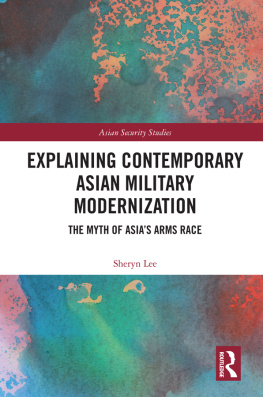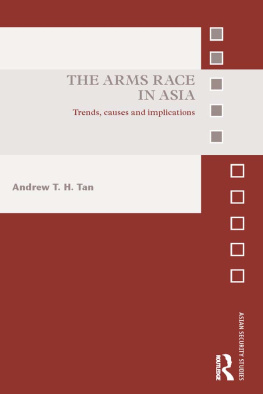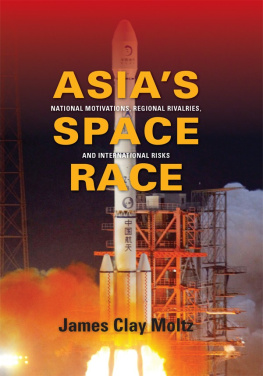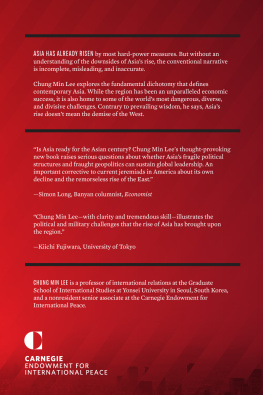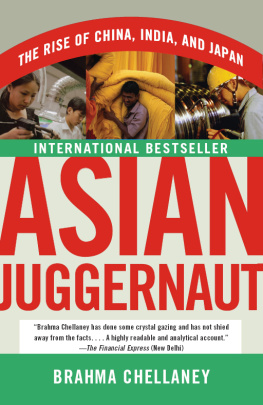Explaining Contemporary Asian Military Modernization
This book proposes a novel theoretical framework of interactive arming in order to explain armament dynamics in contemporary Asia.
Frequently, the modernisation of contemporary naval forces in Asia is described as an arms race, with the underlying assumption being that weapons acquisitions and increases in defence expenditure are competitive and bilateral and due to conflicting purposes or mutual fears. This book argues that the concept of an arms race is an unsuitable one for explaining contemporary military modernisation in 21st-century Asia. Instead, it proposes a novel and innovative concept of interactive arming and argues that what drives conflict is political rivalry, not weapons acquisitions. Instead of perceiving arming as abnormal behaviour, the book views arming as a natural strategic behaviour of states and military modernisation as a basic requirement for a states ability to survive.
This book will be of much interest to students of Asian security, strategic studies and international relations in general.
Sheryn Lee is Lecturer in the Department of Security Studies and Criminology, Macquarie University, Australia.
Asian Security Studies
Series Editors: Sumit Ganguly, Indiana University, USA
Andrew Scobell, Research and Development (RAND) Corporation, USA
Alice Ba, University of Delaware, USA
Few regions of the world are fraught with as many security questions as Asia. Within this region it is possible to study great power rivalries, irredentist conflicts, nuclear and ballistic missile proliferation, secessionist movements, ethnoreligious conflicts and inter-state wars. This book series publishes the best possible scholarship on the security issues affecting the region, and includes detailed empirical studies, theoretically oriented case studies and policy-relevant analyses as well as more general works.
Reshaping the Chinese Military
The PLAs Roles and Missions in the Xi Jinping Era
Edited by Richard A. Bitzinger and James Char
Indias Nuclear Proliferation Policy
The Impact of Secrecy on Decision Making, 19802010
Gaurav Kampani
China and International Nuclear Weapons Proliferation
Strategic Assistance
Henrik Stlhane Hiim
Chinas Quest for Foreign Technology
Beyond Espionage
Edited by William C. Hannas and Didi Kirsten Tatlow
US-China Foreign Relations
Power Transition and its Implications for Europe and Asia
Edited by Robert S. Ross, ystein Tunsj and Wang Dong
Explaining Contemporary Asian Military Modernization
The Myth of Asias Arms Race
Sheryn Lee
For more information about this series, please visit: www.routledge.com/Asian-Security-Studies/book-series/ASS
First published 2021
by Routledge
2 Park Square, Milton Park, Abingdon, Oxon OX14 4RN
and by Routledge
605 Third Avenue, New York, NY 10158
Routledge is an imprint of the Taylor & Francis Group, an informa business
2021 Sheryn Lee
The right of Sheryn Lee to be identified as author of this work has been asserted by her in accordance with sections 77 and 78 of the Copyright, Designs and Patents Act 1988.
All rights reserved. No part of this book may be reprinted or reproduced or utilised in any form or by any electronic, mechanical, or other means, now known or hereafter invented, including photocopying and recording, or in any information storage or retrieval system, without permission in writing from the publishers.
Trademark notice: Product or corporate names may be trademarks or registered trademarks, and are used only for identification and explanation without intent to infringe.
British Library Cataloguing-in-Publication Data
A catalogue record for this book is available from the British Library
Library of Congress Cataloging-in-Publication Data
Names: Lee, Sheryn, author.
Title: Explaining contemporary Asian military modernization : the myth of Asias arms race / Sheryn Lee.
Other titles: Myth of Asias arms race
Description: London ; New York, NY : Routledge/Taylor & Francis Group, 2021. | Series: Asian security studies | Includes bibliographical references and index.
Identifiers: LCCN 2020049591 (print) | LCCN 2020049592 (ebook) | ISBN 9780367506780 (hardback) | ISBN 9781003050773 (ebook)
Subjects: LCSH: AsiaMilitary policy. | Arms raceAsia. | National securityAsia. | Strategic cultureAsia.
Classification: LCC UA830 .L447 2021 (print) | LCC UA830 (ebook) | DDC 355/.03355dc23
LC record available at https://lccn.loc.gov/2020049591
LC ebook record available at https://lccn.loc.gov/2020049592
ISBN: 978-0-367-50678-0 (hbk)
ISBN: 978-0-367-50683-4 (pbk)
ISBN: 978-1-003-05077-3 (ebk)
Typeset in Times New Roman
by Apex CoVantage, LLC
How do Asian arming dynamics interact with one another and why? Ever since the Asian economic miracle of the 1980s, many scholars and journalist have been quick to label arms acquisitions and the capability development of Asias armed forces as an arms race or arms racing. Much of this commentary reflected surprise at the rapid increase in Asian defence expenditure, anxiety about Chinas growing capabilities and bewilderment about some of the major arms acquisitions.1 Despite a decline in the size of the global arms trade, since 1988 Asian countries have held up their share of the market. By the 1990s, Michael Klare had declared the next great arms race was underway in Asia, and Amitav Acharya advised that South-East Asia was already undergoing an arms race.2 More recently, British naval strategist Geoffrey Till maintained that there was an interactive element in the naval modernisation of China, India, Japan, and the US and that this dynamic could potentially evolve into an arms race.3 Moreover, international think tanks such as the International Institute of Strategic Studies (IISS) and the Stockholm International Peace Research Institute (SIPRI) have repeatedly warned of an arms race when analysing the extensive military modernisation of capabilities in the region.
The media further fuelled the perception of a dangerous and uncontrolled regional arms race. For example, the Wall Street Journal declared that the rapid rise in Chinese military spending and greater assertiveness in its territorial claims is fuelling an arms race in the Asia-Pacific region even though many of the countries involved have been hit by an economic slowdown. The Economist, on the other hand, explained that the region was not witnessing a
classical arms race between two great powers, of the sort Britain and Germany engaged in before the First World War, or a Cold War contest like that between America and the Soviet Union. But certainly, Asian countries are competing to modernize their military forces.4
By the end of the 2010s, emerging technologies in the region were also seen by some in the context of arms races.


